#slavic folk stories
Explore tagged Tumblr posts
Text

Perun and Dodola. I think they look good together. Their relationship is such that with her he's a lovely bunny and with others he's a fierce beast. Hmm. Love them))
#folk tales#slavic mythology#slavic#artist on tumblr#character design#digital art#comics#tales of lukomorye#character concept#slavic folklore#love story#lovestories#love#relationship#perun#dodola#graphic novel
79 notes
·
View notes
Text
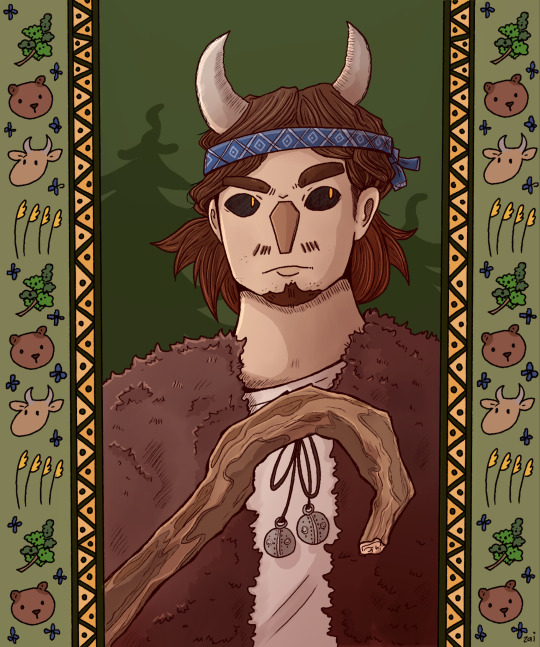
Veles, the god of Underworld and harvest
Accompanying piece to a Veles video I did (:
You can watch it HERE if u were interested :D
#artists on tumblr#art#original art#illustration#mythology#slavic#slavic mythology#slavic folklore#folk stories#folklore#veles#perun#slavic gods
28 notes
·
View notes
Text
Killing Koschei the Deathless always involves an egg. You have to break an egg & the means of killing him is hidden inside. I will never be over the imagery of the seed of death being found within the seed of life. Mortality wrapped up in rebirth.
#& the stories are so old#this imagery is ancient#and so poignant#folklore#folk tales#folk traditions#slavic#mythology#fairy tales#good writing#text post#koschei the deathless
7 notes
·
View notes
Text
They adapted "Чур меня!" "as "Begone!" in English trasnaltion of "And the Haze will take us". -_________________________-

It is not that it is comepletely wrong, it is simply... bland. Chur menya! is a spell/hex for protection from dark forces, according to some sources it's a call to ancestors for protection, but I suppose historians and linguists can argue about that. Well, and translation of Lada's hex against her sister trying to break out of the other world in the forest - no, just no, magic of the words is just gone.
Scratch that, they translated Volkhv as Magus, lmaooooo. AGAIN, it's not wrong, but it's super bland. It's like "Let's find a synonym or equivalent for any obscure word from Slavic languages, why broaden people's horizons".
While people are fighting over inclusivity in the Haze, I'm dying on the hill that English is too bland for translation from Slavic languages, proven by The Witcher games.
#romance club#and the haze will take us#Like what Slavic culture Ru fandom is so pressed about#the only Slavic thing left for English speaking folks in this story is Slavic aesthetics#something-something from what is left of mythology nechist and names
18 notes
·
View notes
Text
when i was a kid, every collection of books—large or small, public or private—had at least one small grubby volume called “fifty japanese fairy tales” “african folk tales” “who’s a-knockin at my door and other scary stories” “haunting mysteries of the sea” “golden threads: slavic fairy stories” “the unabridged grimm’s fairy tales,” and that book would contain at least one short story bizarre and haunting enough to permanently rewire your brain. and babey i was a fucking bloodhound hunting them down
30K notes
·
View notes
Text


I recently completed a front and back cover for this story :)
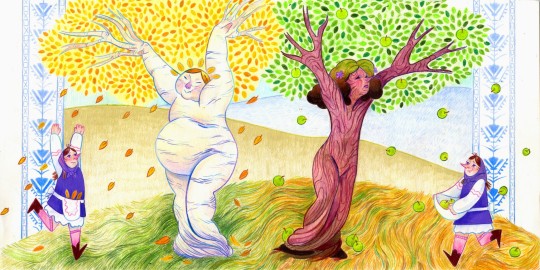
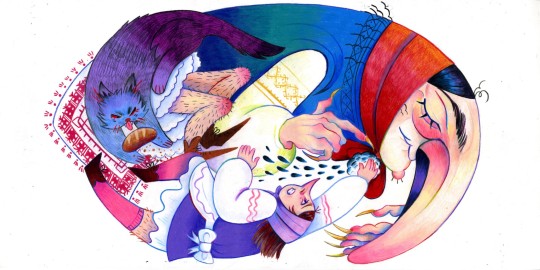
from my recent uni project- Baba Yaga and the Little Brother
#baba yaga#slavic folklore#folklore illustration#folk illustration#folk story#cover art#colour pencil#childrens books#childrens illustration#russian folklore#russian doll#intricate
22 notes
·
View notes
Text
Just a game (part 2) 𝄞⨾


════════════════════════════════════════════
Pairing: Hwang In-ho / The Frontman x fem!reader
Summary: We're getting there, folks. (☞゚ヮ゚)☞ ☜(゚ヮ゚☜) Mostly fluff, need, imagination, fantasy, slow burn. Focus on the f!reader, because you deserve nice things. She's home, receiving odd gifts, some sweet, some...quite the not sweet, the game and plot and trouser legs thicken (I'm so sorry, it's literally 2 a.m. here). In-ho definitely isn't obsessing over you, hatching elaborate plans, thinking of you so hard he'll break another turtleneck. Not saying the f!reader has any specific issues, but if you recognize any, I hope to be nothing but respectful. ♥ Oh, and we have a dream sequence, Freud would be proud.
(This was mainly meant as a "put your feet up and be cozy, read about yourself and feel good" read, the action will come later. Among other things. I'm so sorry, my thesis is driving me mad.)
Warnings: It's the god damn Front Man The usual Squid Game warnings, mdni, stalking, spying, voyeurism, touching, self-touching, sexual themes, sexual almost-intercourse, descriptions of anatomy and body parts, blood, yearning, some terrible references and Slavic folklore. Privacy? In my fic? It's less likely than you think.
Word count: 4.2k
Link to previous Link to next
════════════════════════════════════════════
A cup of tea. A cup. You were watching the cup. Steam rises from it and folds into nothing. Your stomach is churning. Is it stress? You ponder. Seeing the liquid close in on itself as you stir it. Again and again.
"It'll get cold." You say, to no one. You try to breathe. Heart pounding. Head a bit spinny. You look around your room. Dimly lit, warm orange light from a salt lamp. You check your blinds - still closed, still safe. Noise from other people you try to filter out. Why do you jump at every single sound? Why does white noise blaring its head off make for the only atmosphere you can stand? You wonder. You get up. The world spins. The phone lies on your bed. As it has for the last three hours. Unchecked. Your sound is off. It always is. You turned off everything this time. It's just black. You try to think, ground yourself, poems float through your pounding head. You catch a glimpse of yourself in the tall mirrors of your wardrobe. An oddly shaped form stares back at you.
"Jesus Christ…I look…like shit." The mirrored lips curl around your words - but it might as well have been a stranger speaking back at you. You don't recognize yourself, and what you do, you dislike. Like a funhouse mirror. Without the fun. Your long hair falls across your shoulders, curling towards the ends. Your exposed skin is cold and giving a nice exposé of every vein under your neck, driving rivers of blue across your collarbones, your shoulders, your chest. You won't look further. They seem to be drawn to your middle, pooling across your skin. People often referred to you as pale, no matter your actual skin tone. When things got a tad too heavy, you became transparent. It was calming, sometimes. Calming that so much was trying to keep you alive to the point of exhausting itself and sending highways of signals through every vein to keep at it. Your head spins again. More poems. Try to drink the tea.
"Light your candle, one, two, there's a moth…" You know the rest. But the lips fail to speak. You pick up the phone. And almost knock over your tea. Then proceed to fight an urge to fling it into a wall and watch the stains roll down like fresh blood.
Seventeen missed calls from a blocked number - your now ex-companion. A worried message from your friend, no doubt spurred by said ex-companion with an entirely different story to reality. Frowning, you adjust your dressing gown and tie it down to hold everything in and hold you together.
"Hey, Y/N…I know you probably don't want to talk, but I'm sorry things went so badly. I'm here."
You hate yourself a little more. Clara has always been a darling, you…cared for her. A lot. You wish to say "loved", you squint your eyes and wish to say you love her. People are kind. People are always so very kind. And you can't drink a cup of tea. Nor reply. There's also an email. From a set of numbers, no name. You open it, against your better judgement. No subject, only a photograph. Of your door. Your door inside your flat. Which is locked. You didn't ring anyone in. You, of all people, didn't hear any steps on the stairs. You live at the very top floor. And still?! What is wrong with you lately, now of all times?
And still, there is a photograph of your door. With…things? Your shoes were gently placed beside your mat.
"Um…" You knock on your housemate's door - how grateful you are for the economic situation which doesn't permit you to live alone now, you think bitterly as his steps approach.
"Oh, Y/N, how are you? What can I do you for?" Ever the cheerful voice and visage stands before you, half dressed, always flooded with work and hobbies. The room behind him is full of papers and candles, manuals and scripts, and information that probably shouldn't be lying around covered in bird photography snaps. It calms you a tad. You breathe out and uncross your arms. In the back of your mind, you wonder what he's always so entranced with.
"I'm getting there, thank you, Lubo." Your chest falls a tad, you really do feel a bit better, but very on edge. You fidget with your fingers as you speak. "Would it be alright to ask if you could open the main door with me? Something is there and I've been listening to too many IRA anthems to trust it." Because making a joke out of a very serious situation never failed you yet.
"Sure!"
You notice one of the birds on the ground behind him. Gazing at one photograph a little longer, you smile at the birdie and its soft grey feathers, little black dash across its little eyes...you realise you're looking at a shrike. The universe really is sending her best.
════════════════════════════════════════════
You open the door as Lubo endeavours to rummage through the things on your doorstep. It seems to be a very neatly wrapped black box with a pink bow. With a little token of a crow embossed on its side. Heavy, by the looks of it. You half expect your ex-companion's limbs to be soaking its insides.
"I'll take it indoors and disinfect it, ok? Just so it doesn't feel like you've contaminated the flat." You nod, thank him over and over, and feel very grateful for him remembering your slight fights with obsessive cleanliness and parasites. But this looks…clean. You take a knife from your room, the knife that's been under your pillow for good reason. Kneeling, you gently unwrap the box altogether and distance yourself from the thing for a little bit. Breathe. It's just a box. Those never go wrong.
It's…full of…gifts?
Your…favourite flowers, perfectly preserved. No one knows your favourite flowers that well. Under them, resting under jewels of crimson poppies, lies a book of poems, the ones you use to calm yourself down; the ones that make you feel less alone. In the correct languge, even. Next to the poppies, hot water bottles, wrapped, fluffy, still warm. Under them yet, medication you couldn't get from your doctor for the entire month due to disagreements and never being heard, half of them aren't even sold in the country. Bath salts, dark chocolate, tea…there seems to be so much. Your face is caught in a mixture of attempting to frown, being swept off your feet, and deeply uncomfortable with what is basically an encyclopedia of you in a box. You carefully lay the items to the side and begin to notice things you truly need your housemate to not see. You lose your breath for a moment and blush so hard you almost forget both the kindness and terror of the rest of the package. It seems to be divided into care for you and…some other forms of urges. As if. As fucking if.
"Google, remind me to photograph this tomorrow in good light," you say to nothing, "to use as evidence either after this person manages to kill me or before, if the courts move faster than an asthmatic ant with heavy shopping."
Against your better judgement, you carry the box to your room and watch it for a while, as you do other things, but can never quite relax. Surely he can't be serious. Your name isn't Shirley.
There was also a note you now keep flinging on your table and crunching in your hands, neatly written, with no name.
"Dear Y/N,
should you wish to meet someone qualified to help with the attached records, it has been arranged. Be at the coordinates listed between the red and white gift and you will be taken care of. No harm will come to you. You are safe. As right as rain."
Right as rain…that's a part of a poem, that absolute…dear God, fuck, the thoughts in your head are tumbling down at you and you collapse onto the bed, staring at your knees. It's a good thing he somehow didn't include your most loved flowers, since they're all poisonous. One of them you like specifically because it is elegant, sharp, snowy, and beautiful - and all of her body, leaves, and seed pouches scream "don't fucking touch me, if you do, you will die and wish for death the entire time you are doing so". You would very much like to be the flower now. Make someone else hallucinate.
You search the box again and find the beautiful gown, in red, and the gentle white lace undergarments - as kind and gentle and revealing as they are elegant. A little QR code is nestled between the lace.
"Nope. Nope nope NOPE. Absolutely not," you say out loud. Fighting the fact that the nightgown under the two other garments is cozy and light and so very beautiful. And it smells…oddly familiar. With a hint of something else. As if someone knew you loved scents of sweetness, vanilla, caramel, honey, and skin combined with darker, heavier tones that don't usually mix with feminine perfumes. Something lovely and gentle to draw you in, with something far more potent, enveloping, and enthralling to drag you down the lake to drown. And yet. Still. Something else. Something more. You decide to put on the gown and stare into a little crow's eyes. Such a pretty little statue, you don't even remember where you got it from.
"I'm going to be alright. Water is fine. This is just water. We've been here, we've been in the mud up to our noses." You are whispering to yourself, trying to sooth your mind. Metaphores, poems, sooth sooth sooth. You close your eyes, think of beautiful women, barefoot, in the dark of a forest. Glistening lights in their long hair, lights in their gorgeous eyes. Light on their feet, as they dance upon the water and through the marsh. You cannot drown a forest spirit of a woman scorned. They will mesmerize you, dance you, dance you to the end of your love and tether, and pull you into the depths. Then kiss you as you gasp for air.
You undress, eyes still closed, holding the long white gown. You slowly slide into the fabric, which clings to your skin as a lover's touch at the first sign of morning light. Still trying to be as unbothered and confident as a forest Rusalka. You aren't. But the gown smells nice. And it's quite light. Long sleeves, fabric that reveals but doesn't scream. Lace around your chest and stomach, falling down your hips and thighs.
…Kiss you as you gasp for air.
════════════════════════════════════════════
In-ho was pleased with his gift. Not only the gift, but the message. Upon message. Upon message. He wondered, quite hopeful - yet reserved - if you understood them all. No matter.
You will. Oh, you will. Every word. Even if he has to cling them to your skin, one by one, with his own lips.
To the surprise of absolutely no one except you, perhaps, the small bird brought him all the feedback he could desire. Rather low quality feedback, he thought, as he watched you ponder, watched you crunch up the note, and watched you dress. Instinctively, he looked away as you began to slide your own clothes down. He glimpsed perhaps a strap, perhaps more skin than he first saw…light reflecting off you, sliding down, further down, caressing your tenderness…yet he looked away, calmly resolute to not look back. His gaze remained firmly in the corner of the room, he certainly wasn't fighting - or imagining himself being the photons of light resting on your supple skin. No. It would be unbecoming to watch a lady undress, so vulnerable, so unknowing. Never mind the rest. If you looked up the word "hypocrite" in the dictionary, In-ho's face wouldn't be next to it. It would be on the next page, because he would never be caught. As he looked back, you were dressed, not looking at yourself.
In-ho frowns for a moment, before he sees the rest of you. Even though it's just a phone screen and the picture quality truly isn't doing you justice, his breath is caught. He shifts and looks around instinctively, only a flicker of the eyes and a small movement of the neck. But he's nervous, nervous to be so exposed. He chuckles to himself just as unnoticeably - he's spying on you yet he's the one feeling exposed..was the chuckle to ease tension? This is just a game to him and you are nothing, after all. No one. He shifts once more and uncrosses his legs, one hand slowly combing his hair firmly away from of his forehead. Nothing. Just as it is nothing that is making the jacket around his neck feel tight. He sees you stand, further away now. He sees your entirety in the white flowing fabric, the lace, the…entirety…of you. His coat needs to come off, and is discarded to the side in haste. The remaining turtleneck isn't much help, but he goes in, now fully enthralled. Positioning himself, he endeavours to enjoy you. Slowly. From the tip of your head to the soles of your feet, remaining fully in control, admiring, never taking, never grabbing. Never…needing. But as he moves down your face, your cheeks, your chin, along your neck all the way to your hair resting on your now exposed shoulders, back to your mouth and lips - he leans into the screen - those supple yet reserved, tender lips whispering gently and curling around words as if speaking to a sleeping lover in the night who is caught in a bad dream, the eyes - damn the picture quality - the eyes that glint, yet resemble dark pools amid features that are…that mean…his heart is fast. His eyes pools of reckless abandon. They flicker to the movement of your hips and tick fast, fast back up top, stopping at the almond curve the nightgown begets your breasts - In-ho's hands twitch as his fingers yearn with a mind of their own, to hear you gasp and squirm and melt under their touch as he teases, cups, and caresses in the gown's place. Tender flowers, waiting to be kissed. As you move, for him, for his eyes only, his mind floods through its inhibitions and begins racing on instinct - yet does so wrapped in cotton; barely subdued. Algorithms, scenarios, plans - ten a second - gather in his mind - resting on nothing but your features, spurred into existence by you, your lips, your form, your movement. He's watching the last flame dance before him in a sea of suffocating darkness, and it is his. Tension grips The Frontman's trousers as he digs his fingers in to feel something, anything, as if to drag himself back, painfully if need be - all this…for a low quality moving picture of you.
You. Your self before him. No adjective does it justice to In-ho, no painter could stroke its surface, nobody could own this moment. Nobody but him. And he cannot reach, reach through the screen, for you, for you mean…you in your entirety, before him, vulnerable, bare, unknowing, both a deity to be worshipped and a form to be devoured and left pleading, barely breathing under him, his grasp, his hot breath, you, you mean…
…nothing to him. In-ho leans back again. He breathes a bit faster, containing himself. As his breath slows and features fall back into place, he straightens the trouser leg and exhales. Your name is on his lips as he does so; he whispers it to himself. A name that doesn't seem to leave his tongue, no matter how many times it wraps around every syllable.
"Y/N, Y/N, Y/N…you are nothing."
He turns off the screen with one click. "Nothing." He gets up, leaving the phone behind. He is back to his true self - unbothered, cold, empty. A statue of stone. It was fun while it lasted, but the shell he wears gets tired of the falsity imbued in it during these little sidesteps. Little adventures to ease the monotony. Your records lie on the table, next to his glass of dark liquer. He walks over slowly, cradles it, sipping with restraint, and puts it down just as slowly in the exact same place. He goes on with his evening, thinking, it must be said, of nothing. He continues his work, thinking of nothing. Nothing replaces the drabble of his underlings as they update him on the latest games. Nothing is on his mind as he showers, nothing is in the water that glides down his own body. Nothing is in the warmth that he doesn't imagine being replaced nor coming from a different source. The voice of nothing is in the hiss and humm of the shower, nothing sings to him sweetly as it envelops his form. Nothing is woven into his satin sheets, nothing still smells of the perfume he picked for you, nothing is in his bed and pillows and nothing is slowly, invariably, fatally invading his mind. The cologne he uses, the same cologne he rubbed upon certain parts of the gown you now rest in, isn't combining and wildly interweaving with your gentle, warm, sweet, yet heavy scent. Nothing is everywhere and nothing is driving him absolutely stark, staring mad as he lays there - naked, exposed, amid satin sheets, it is nothing that invades his dreams and wraps him in sensations he can still only dream of.
════════════════════════════════════════════
Barren lands and dusk. No flowers. No life. In-ho is alone. As far as the eye can see lies nothing. He cannot feel his mask. A shape is in front of him, laying there, incredulous. Unfitting its surroundings. As if guided by an unseen hand, he walks up to her slowly and kneels beside her. She is dressed in white fabric, falling across her skin, exposing more than is becoming of such a form. Her hand is resting next to her head, her other at her side. She is peacefully asleep. A gentle humm escapes her lips - she must be dreaming. In-ho glides the back of his hand everso carefully across her cheek, guiding it down her neck and stopping at her collarbones. Her chest lifts in a slow rhythm as her skin touches his. She is his. Is she not? He could...open his hand, and his hand opens. He could place it around her neck, and he does. As he feels her warmth and blood pumping into his hand, he thinks he could squeeze and hold down. He doesn't. The form reacts to his intentions, seemingly, her face frowning in the most unnoticeable way, lips falling from their previous peaceful expression to a worried frown. As if caught in a bad dream.
No, no, no.
In-ho releases the pressure and merely rests his hand on her neck, pushing errant strands of hair away from her skin. They fall around her shoulders and between the fingers of his other hand, which lifts instinctively to cradle her head. Her expression relaxes, and he smiles almost on instinct. Suddenly, her eyes flutter open and gaze into his own, almost unblinking and holding his gaze. The pools of comforting darkness set in an innocent visage drive electrical current through his entire body and In-ho almost has to steady himself against the ground where his hand is holding her head, still. She isn't scared, she only gazes and studies, lays, and rests in his own dark eyes. Her smile mirrors his. As if the two of them were already familiar, already far beyond anything novel. She whispers to him.
"Darling, this isn't your place."
In-ho doesn't think, he knows the voice. The gentle, slow, melodic whisper that he wishes to hear before he goes to sleep himself. Putting more strength into his grip, he places his dominant palm in hers as it still lays beside her head. He squeezes her down. Without thought, his body shifts to move above hers, holding her gaze, now directly on top of her, without touching her body with his. His hands no longer gentle, but firmly holding down. His thumb caresses her cheek as his other hand pushes her palm into the ground.
"It doesn't need to be."
As the sentence barely left his lips, he connects them with her neck, firmly kissing the skin and pulling her into his bite. The taste is intoxicating, and beckons for more. Sweet, tender, pure, intoxicating. Down her neck he plants kisses and barely restrained bites, gliding his touch, gripping her hand and moving his other to her neck once more. He hears gasps and timid moans, and he moves down, lips brushing against her chest and resting upon it. He lets go of her hand and finally grips her, under the small of her back, caressing and squeezing her waist, lifting her body into his. Now he feels her. Now he feels her being react and pressure and squirm, now he feels the pulse of her body directly under his and melting into him. Every movement, every gasp, every beat of her heart - in his control, under him, sinking into him. Her waist lifts against his and he eagerly helps it up, feeling his need against her body, finally, all he needs to do is tear off the gown, take her, make her fully his and hear her cries and moans as he takes what is his. Still in control of himself, he fully recognizes his itch, his need, his voracious hunger. He recognizes it and fully gives into it.
But the dream does not let him.
Something is wrong. The body is colder now, her breathing is slow, her voice no longer caressing him, her being no longer reacting to his touch. The current fizzled out. Pulling away, he sees the damage done - even as her eyes are wistful and her smile still there, it is sorrowful and soft, gazing down at him although broken under him. He sees her neck and chest, her breasts exposed, her skin red with bite marks, red with his signatures. Lines where his grip failed to falter rest on her tender flesh, her pallor a canvas for his need and depravity. For his destruction. He does not want this, he does not want her like this, his mind races and tries to get back in control but cannot. The canvas before him begins to soak through in crimson, blood pools into the white fabric where he lay and pushed and tried to take her. As he watches the gown cling to her stomach with blood, fear drives cold daggers through his back. He is no longer the Front Man, he is himself. Himself before a Front Man ever was. And he is...scared. Still her voice reaches him, doing nothing to alleviate his state, doing nothing to destroy the damn invisible barrier that keeps him from holding her close, holding her together, holding him together.
"Not like this darling, not like this again."
How is she still smiling? How does she seem so cold yet encompassing an utter lack of proximity? Holding her now seems like the most sacriligeous, repugnant thing he could do. His hands shiver lightly, how is he afraid to touch her now? After all that? She is his, his, this is all so incredibly wrong! He doesn't care, he doesn't have feelings for such frivolities, she is a dime a dozen, she is worth nothing, and she is nothing to him; nothing.
And she's still smiling, a little laugh escaping her lips as if she can hear his inner turmoil and has seen it thrice before.
"Taking what you want, never what you need."
In-ho looks down at his own body, which begins to feel cold and wrong. As if missing something vital. He smells copper, his hand feels hot as he touches his chest yet his body grows colder. The last thing he remembers before waking up in a freezing sweat is looking down at his own body, now filled with open chasms wherever it touched hers - gaping empty holes that can be filled with nothing, bleeding him into the ground as she watches on.
In-ho gasps, springs up into a seated position and touches his chest, his stomach - and breathes in relief. As he is composing himself, a new manner of play begins to form in his mind. Between hurried breaths and elevated pulse beats, he plans a new way to play this game and win.
#hwang in-ho#hwang inho#the front man#squid game#squid game x y/n#squid game x oc#squid game x reader#hwang in ho x reader#writers on tumblr#in ho x reader#hwang in ho#in ho x you#in-ho x fem!reader#in ho x f!reader#squid game front man#in-ho x y/n#in ho x y/n#my writing#fanfiction
87 notes
·
View notes
Text
My biggest hot take: I do not believe an author should be using mythology and religion (or even culture) to make things marketable and easily relatable (by popular reference) for a reader. Let me explain:
My biggest problem with SJM is that she continuously takes from religions and mixes and matches them in ways they should never be matched, and will disrespect both religions in the process. She will pass sacred terms off as her own, or use it to fill the holes in shitty world building. Forgive me but I do NOT think that real religions should be filling the holes of fantasy world building.
This is coming from a Pagan of course, but I’ve compiled an entire list of atrocities SJM has put together. This ranges anywhere from combining so religions that should never mix, using a traumatic sacred part of a religion and using it as a plot device in a random fantasy world, or even using something from a closed practice.
I bring this up especially now because I’ve seen certain types of fans who tend to enjoy making fun of mythologies, and dismissing the views of people who practice those beliefs because “they don’t believe in that religion, it’s fake, so why should they acknowledge someone’s frustration?”. I’ve had so many people tell me “that religion isn’t real, get over it, [insert author, usually SJM] is actually a genius for combining these mythologies”! Like I’m sorry, pardon me if I don’t think a creature from closed Indigenous practices should be mixed with Slavic deities and Celtic/Gaelic folklore.
It all boils down to empathy on the end of fans, and it boils down to actually putting in effort when it comes to authors.
And of course this is definitely not to say you can’t have mythology in your stories if it serves a purpose. I just think it’s so incredibly lazy to mix and match mythologies and slap them together and call that your world building.
And for those of you who want to tell me that SJM got a degree in world religions or whatever the hell:
That is not an excuse for lazy fucking writing. Not only is it not an excuse, it’s an insult to authors who also study the same thing, put in the work, and really produce excellent material regarding those mythologies or folklore.
Thjs is why I don’t trust people who say they like ACOTAR over The Folk Of The Air Series. Because what do you mean you prefer a poorly mashed up plot held together by a piece of string than a really fascinating depiction of fae folklore and its effect on humans? Wild to me. Fucking wild.
62 notes
·
View notes
Text
“The most important thing was going back to the folklore and the early Balkan and Slavic folklore [...] Most surprisingly, many of these early folk vampires do not even drink blood; rather, they might suffocate their victims to death or spread plague and disease.”
“I had to make the vampire as scary as possible”: Nosferatu’s Robert Eggers on how folklore fuelled his film

There’s no “sexual assault” going on in this scene. The “underage crime” here is attempted murder. Count Orlok wants Ellen’s soul (“and you shall be one with me, ever-eternally. Do you swear?”). She just swore it, and then starts masturbating. Since the narrative establishes it’s sexual energy that conjures Orlok, he materializes inside of her head, as a vision-nightmare. He grabs her neck, trying to choke her to death, to make her fulfill her promise to him. He’s already dead, there’s no “vampire eternal life” in this story: Orlok victims don’t turn into vampires, they just die because being bitten by strigoi doesn’t turn the victim into one. He’s a strigoi-morti from Balkan folklore; he’s dragging his living relative (reincarnation of his wife) to her grave like your typical strigoi.
One known type of strigoi haunting “method” in Romanian folklore is the “strangler”. Where the strigoi produces nightmares and attacks his victims by strangling them, and suffocating them with the purpose of killing them. Which is what we see in “Nosferatu” (2024) with Ellen at the prologue, Thomas Hutter and Anna Harding.



“I can’t breathe!”
#Nosferatu 2024#Nosferatu#Robert Eggers#ellen hutter 2024#Ellen hutter#Count Orlok 2024#Count Orlok#Thomas hutter 2024#anna harding#strigoi#romanian folklore#orlok x ellen#ellen x orlok#lilac fangs#lilac fang
59 notes
·
View notes
Note
hey Nev! Out of curiosity, do you have any other ocs besides Laura?
I find your stuff super neat!
Thank you so much!! And yes, I got a few!
I've posted about Bojana and Síomha before, however briefly,


Then there's these two which are quite old (from my demon slayer hyperfixation in 2022). Nobuko was a self-insert from an AU with friends.


I can also share the characters I made for my end of the year project for school, for a folk fairytale-inspired type of story based on Serbian and slavic stories I grew up with.






#sigh I need to make more#ask response#my art#quite proud of Baba Roga's design ngl. very stylish#the fox is intersex and he/him NB btw#bc I find it very funny#(my dad used to tell me that female foxes had black tips on their tails and males had white)#also trickster spirits. they don't know gender#please don't judge the kny oc art. it's been a while.
47 notes
·
View notes
Note
I love your COTL art! I was wondering, what are your design inspirations for the Lamb’s clothing, if you have any off the top of your head? It’s gorgeous!
Oh I've been waiting for this question. Ok! Design Inspo time! I like clothing that represents the character, and Lamb (mine at least) is a person who came from a folk culture. I think of Slavic clothing: Belarus, Czech, Serbia etc. etc. You get the point. I grew up with Slav fairytales and drooled over these illustrations when I was younger.

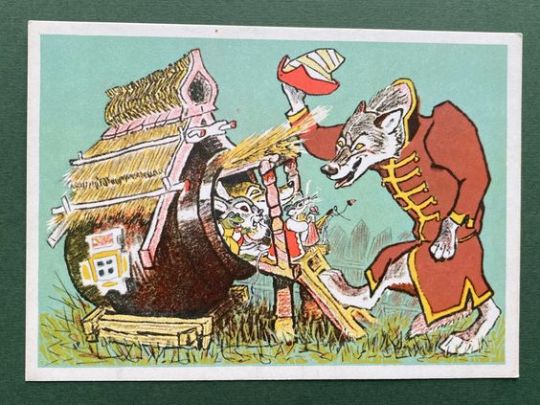
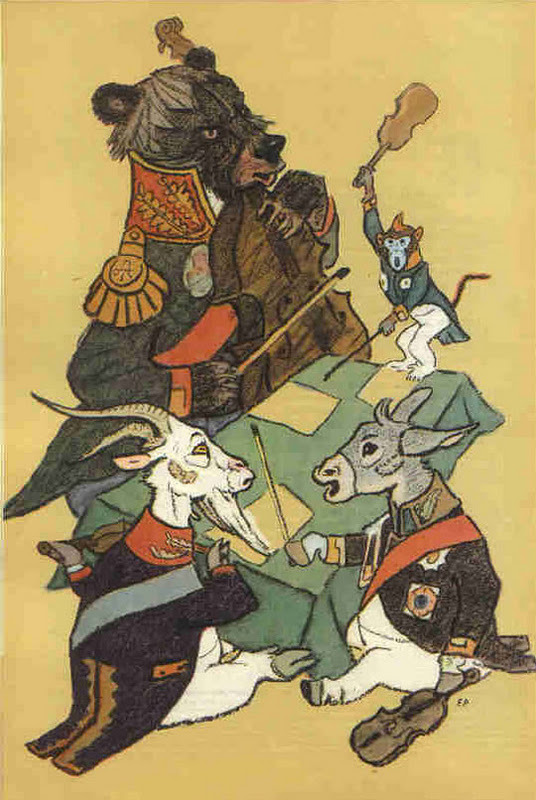
I wanted to capture the spirit of these illustrations cause I thought it's a perfect fit for my vision of the story in "Cult of the Lamb". Now, Slavic clothing is a BIG inspo for their clothing but it's not only, It's also Indian, Moroccan, Swiss, Greek, Balkan, and Swedish even, it's an eclectic mess of everything.
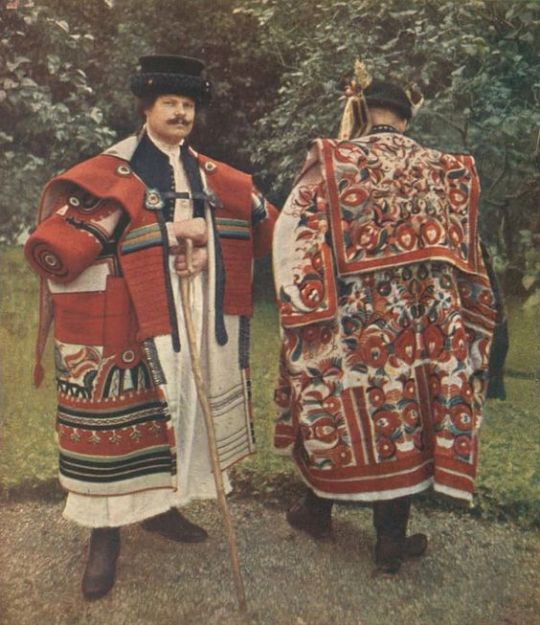


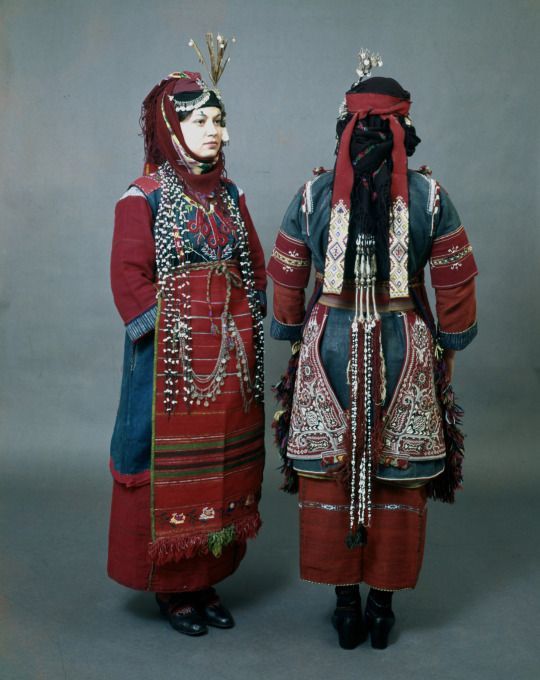
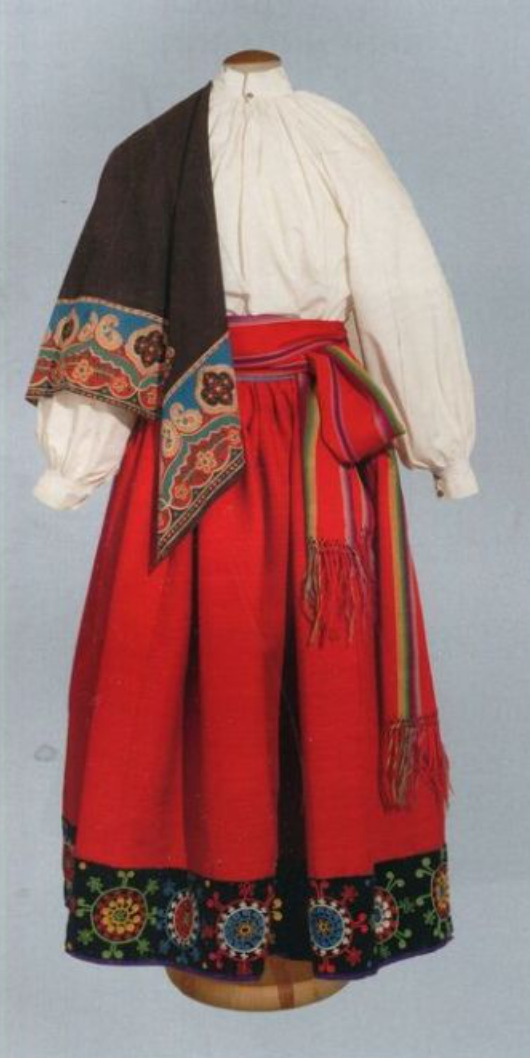
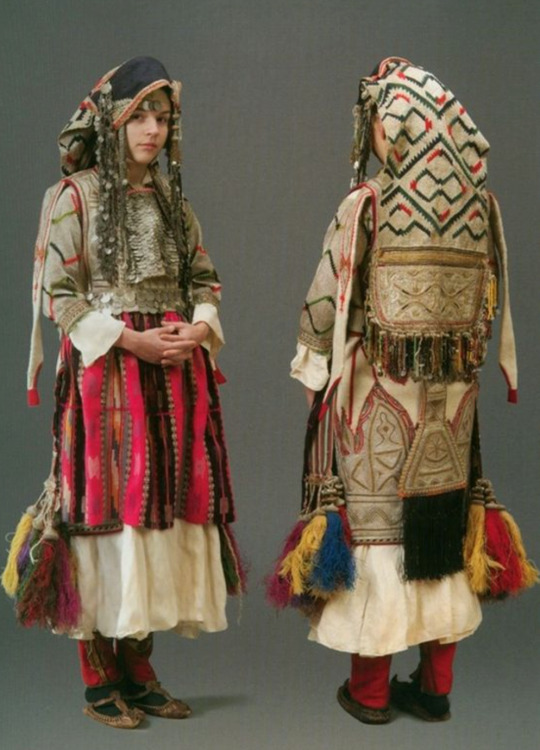
What all of these clothing have in clothing have in common is ornate patterns, big flowing comfortable cloth, and bright colors. Which for me fits perfectly with Lamb's white wool.

170 notes
·
View notes
Text
youtube
Slavic vampires?? In this economy??
I made a new video! Feel free to check it out :D
#slavic#vampires#slavic vampires#slavic mythology#slavic mythos#folklore#slavic folklore#mythology#czech#folk stories#history#vampire history#Youtube
19 notes
·
View notes
Text

Thank you for the question @newbiepagancat ! I’ll give you a direct answer and a broader view answer.
Direct answer: The general theme of the myth was reconstructed by slavists on the basis of folk songs, folktales and comparative mythology, there is no one concrete historical source. The names of gods and the storyline connecting multiple myths are an educated speculation by slavists of yore. The minute details are typically added by neopagans as they’re almost impossible to reconstruct.
The Russian philologists Ivanov and Toporov found (mainly on the tradition about Zeleni Jurij) traces of the principal myth of Perun and Veles, linking Jurij/Jarylo with the Balto-Slavic Jarovit, a deity of fertility, who was initially worshipped on April 15. Furthermore, Radoslav Katičić wrote extensively on Jurij’s myth among the Slavs and on the duel between the Thunder God with a dragon. Both Radoslav Katičić and Vitomir Belaj share the opinion that Jurij/Jarylo is the son of Perun and thus central to the pre-Slavic vegetation and fertility myth. Jurij was taken by envoys of Veles to the land of the dead from which he returned to the world of the living in spring. As a harbinger of spring, Zeleni Jurij is also connected with the circular flow of time and with renewal. According to Katičić’s reconstruction of the myth of Zeleni Jurij, the mythic story recounts how young Jurij rides his horse from afar, from the land of eternal spring and the land of the dead – from Veles’ land – across a blood-stained sea, through a mountain to a green field. (…) At the end of his journey, Jurij arrives at the door of Perun’s court to marry Perun’s daughter, (his own sister) Mara. Together with the sacrifice of the horse, the hieros gamos ensures the growth and fertility of plants. Some Slovene folktales and songs also mention an incestuous relationship between a brother and a sister, which is the reminiscence of the sacred marriage already mentioned in the myth of Kresnik. The sacred marriage is therefore also connected with Zeleni Jurij.
- Supernatural beings from Slovenian myth and folktales by Monika Kropej
Mikhailov summarized Ivanov’s and Toporov’s reconstruction of the basic myth by describing that the thunder god Perun, who dwells in the sky on the top of a mountain, persecutes his enemy, who has the form of a snake and lives below on earth. The reason for their conflict is that Veles stole cattle and people, as well as the Thunderer’s wife in some versions of the story.
- René Girard’s Scapegoating and Stereotypes of Persecution in the Divine Battle between Veles and Perun by Mirjana Borenović
Broader worldview answer: There are some common mythological themes that exist in one form or another among countless different cultures and peoples, adjusted to fit the local gods and their broader stories.
The God of Thunder fights The Serpent of the Waters. They have to fight - be it as Perun and Veles, as Thor and Jörmungandr, as Zeus and Typhon or as Marduk and Tiamat. The detailed reasons will vary but will make sense locally. The older and simpler reason is likely that we need a good justification for the changing of the seasons.
The Death will always take away someone’s Loved One, sometimes that Loved One will be a child, since that makes coping with the situation particularly difficult. That’s just what death does - be it as Veles and Yarilo or as Hades and Persephone. Bonus points for explaining the seasons changing too.
So let’s say you’re a slavist or a neopagan desperate for a coherent body of Slavic myths but lacking one. All you have to work with are some fleshless skeletons of myths, painstakingly glued together from random bones that you found here and there. Truth be told you only managed to get this far because they’re real classics of the genre and other cultures tend to have similar ones too. Let’s introduce the skeleton gallery in play here:
The Thunderer and the Serpent are fighting (described more in depth here),
The God of Death/Underworld abducts a child (described in the quotes above),
The Spirit of Vegetation has to die - creative sacrifice/murder (explained shortly here),
The Fire and Water need to marry at Midsummer - magical incest temporarily allowed (explained in this post, if it’s too long just read the last quote and the tldr).
(You might notice pretty much all those myths are centered around vegetation, what makes plants grow, and people needing to have food. Two first skeletons do a decent job of explaining change of seasons and the reason for seasonal coming of rains, that are needed for the fields to grow; two last ones are related to rituals that are supposed to ensure that land stays fertile/there’s enough sun and water so that grain grows and we can avoid starving.)
Ok, so let’s say you’re a slavist or a neopagan desperate for a coherent body of Slavic myths. What is the optimal way to connect the dots here?
Perun and Veles fight. Why are they fighting? Multiple reasons but the biggest one is Veles stealing something that rightfully belonged to Perun. What did he steal? Well the myth works perfectly if it’s a) a child and b) a spirit of vegetation. This fits both Morana and Yarilo and I saw fans of both versions, but let’s go with Yarilo here. Because of a flower, a folk song and an old chronicle Yarilo/Yarovit, the spirit believed to be one of vegetation, life, spring, sun etc. has to marry the spirit of vegetation, water and death, that miiiiiight also be his sister. How the fuck do you marry your own sister? Well you got abducted and separated at young age, but as The Spring, The Embodiment of Sprouting Seeds and maybe also The Sun Child, Yarilo (born at Midwinter) will come out from the Underworld uscathed as a young adult and meet a girl who he fails to recognize as his sister and marries at Midsummer (part of fertility ritual for good harvest). Anyway tragedy follows, could be murder, could be suicide, either way it has to be death.
Why? Because that’s what makes sense, the most optimal way to put together the puzzle pieces that we currently have. Does that mean that’s exactly what Ancient Slavs believed? No, but a) we don’t know for sure what they believed and will likely never find out for sure, b) they probably believed bunch of different, conflicting stories depending on the region.
Obviosuly speculating slavists are much more light-handed than speculating neopagans. The slavists will usually let you know which parts they added, why they hold this particular belief, what purpose this story may serve, what other authorities support their hypothesis, and of course, that nothing is for sure and this is merely a hypothesis. Neopagans are rarely this kind and forthcoming.
Have a lovely day!
Zarya
#slavic paganism#slavic mythology#slavic folklore#Perun#Veles#Yarilo#Jarilo#Morana#Marzanna#Marena#Pls don’t tell my boss what I’m doing at work#asks
52 notes
·
View notes
Text
Nocnitsa, the night hag [Slavic mythology]:

Nocnitsa is a hag or witch from Slavic folklore who inhabits woods and forests. She is heavily associated with night and darkness, and as such, she mainly targets sleeping children at night. A deeply evil creature, Nocnitsa usually bestows nightmares onto her victims, but she other ways of inflicting suffering: sometimes she shows up at night to breastfeed infants, but her milk is highly poisonous and will cause the child to fall ill.
In this aspect, she is associated with the Rusalka, another supernatural female monster that kills with her breasts. Sometimes, the breasts of a Rusalka were said to be made of iron or stone, and she would crush her victims to death with them.
To appease Nocnitsa, people would make offerings of bread (sometimes also salt), which would then be rubbed on the child. There are also certain charms or rituals to ward off the witch and cure a child’s insomnia. Alternatively, young children could be protected against Nocnitsa with a protective circle or by simply placing a knife under the cradle.
She is also called Nochnitsy (or a variation), Kriksy (meaning “scream”) and Plaksy (“the sniveler”, “one who snivels”), sometimes combined into the name ‘Kriksa-Plaksa’. In Belarus, Nochnitsy were a group of tiny spirits instead of a witch, but the principle remained the same. The Nochnitsy caused children to sleep badly, but they were deeply afraid of fire. To cure an infant cursed by the Nochnitsy, parents would make them sleep in front of the fireplace, or sometimes put onto a large tray or shovel and put in an oven for a short while (note: a smoldering warm oven, not a burning one. Please do not put babies in burning ovens).

Interestingly, Nochnitsa (if it is indeed the same character) plays a minor role in the Slavic story of Pizamar, a mortal woman who fell in love with the god Svarozhich. Unfortunately, the gods forbade love between mortals and deities, so Pizamar tried to take her own life. She walked towards a cliff at night, but right before she could jump off, Nochnitsa cast a sleep spell on her.
Every time she tried to commit suicide, Nochnitsa put her to sleep. Lada and Chors, two goddesses, watched this scenario unfold several times before taking pity on Pizamar. They stole divine mead of immortality from the other gods and gave it to her, turning her immortal. Pizamar then became the entertainer of the gods, dancing and singing for them, which she did with such passion and talent that she eventually became the goddess of the arts.
Sources: Rose, C., 1996, Spirits, Fairies, Gnomes and Goblins: An Encyclopedia of the Little People, Bloomsbury Academic, 370 pp., p. 130, p. 186. Bane, T., 2013, Encyclopedia of Fairies in World Folklore and Mythology, McFarland, 428 pp., p. 277. Kliauz, V., 2001, Video-Recording Ritual Incantations and Folk Cures (1), Institute of World Literature, Moscow, SEEFA Journal, VI (2), 28-34. Bane, T., 2016, Encyclopedia of Beasts and Monsters in Myth, Legend and Folklore, McFarland, 428 pp., p. 241. Valodzina Tatyana, 2006, ‘Unchristened Flesh’: the Woman’s Breast and Breastfeeding in Traditional Slavic Culture, with Especial Reference to Belorussian, Forum for Antropology and Culture, No3, 168-192. Monaghan, P., 2014, Encyclopedia of Goddesses and Heroines, New World Library, 448 pp., p. 306. Min’ko, L. I., 1973, Magical Curing (Its Sources and Character and the Causes of its Prevalence, Soviet Anthropology and Archeology, 12:1, 3-33. (image source 1: Vasilyna Holod on Artstation) (image source 2: Alexandru Munteanu on Artstation)
#Slavic mythology#witches#mythical creatures#folklore#world mythology#mythology#sometimes I only use a few lines of information from a lot of sources#and then my bibliography is almost as long as the rest of the post
40 notes
·
View notes
Text
Pirot Kilim ornaments

Чурлињак (čurlinjak) - The most basic motif, representing a cross section of the lower part of the whisk for mixing ingredients (called čurlinjak).
Врашко колено (Devil's knee) - The motif comes from the pre-Christian Slavic religion. It symbolises movement in circles (kolo dance) and the flow of life, and provides strength, bravery and defense against evil.
Корњача/жељка (turtle) - The most popular pattern of the Pirot Kilim. It symbolises durability and longevity and brings fertility, healthy life and protection from danger.
Ченђели (čenđeli) - Represents a grappling hook mounted on a wooden pole, used for hanging things.
Бомбе (bombs) - It beard this name due to its semblance to handgranades, but the motif has existed since before handgrandes were invented. It provides strength and energy, especially to men, so the kilims with this motif were usually gifted to boys for their life milestones.
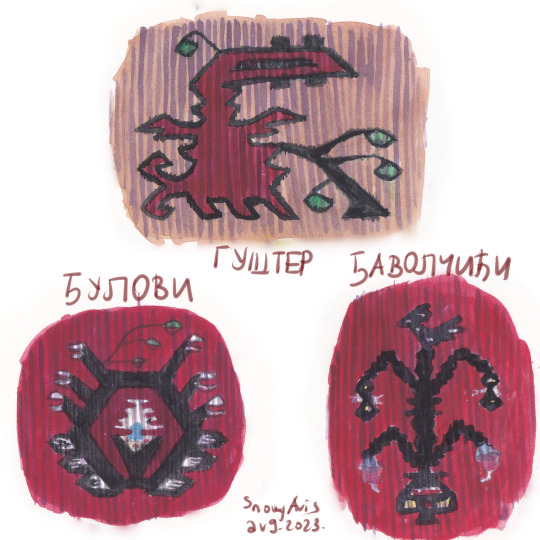
Гуштер (lizard) - This pattern probably originates from modified depictions of dragons. It represents laziness and indifference, but also change, flexibility and adaptation to the world.
Ђулови (roses) - It represents a stylised cross section of a rose, showing both the exterior as well as the pistils, anthers and seeds inside. It is symbolises a young woman and her beauty. Kilims with this motif are often gifted to daughters by their mothers. Different variations of this motif exist, some of which (the roses on shackles) were, according to legends, made as rebellion of kilim weavers against the Ottoman repression.
Ђаволчићи (Little Devils) - The devil is represented as a human figure turned upside down, with the devil's head turned towards the underworld, and a bird on the other side representing the heaven.

Гугутка (dove) - Birds protect from evil spirits and diseases and connect the earth and sky. It represents family harmony, love, peace and joy, and as such kilims with this motif are often gifted to new homeowners. This motif can often be seen arranged around a pole, representing a tree full of birds.
Атапот (atapot) - It represents an octopus, and the name probably came from a distorted pronunciation of the word oktopod (octopus).
Француске бомбоне (French candies) - This motif was probably inspired by silk candy wrapped in decorative paper and brought to Serbia from distant lands. According to a folk story, when the French soldiers liberated Pirot in the First World War in 1918, the kilim weavers designed this pattern as a sign of gratitude.
Столица (chair) - It represents an antique chair and the inspiration for this pattern came from the everyday life of the kilim weavers.
Тиче (tiče) - It represents a small bird.
Source: "Ornaments of Serbia: the Pirot Kilim" by Milica Živadinović. Art by me.
#art#water color art#serbia#serbian#kilim rug#folklore#balkans#balkan#traditional art#water colour art#slavs#slavic#south slavic
404 notes
·
View notes
Text
Yandere One Piece - Irish/Nordic Fae Folk Myth X F!Reader - Prologue
It's a spooky season, and I have yet to see any Yandere One Piece reader fics based on Slavic myths and legends! Blame me for being too invested in Bramble: the Mountain King game.
---
Once, there was a childless couple who lived in a quaint village. Although the village is rich in tradition and harvest, it was also a fearsome place. Not far from them lies a great forest called the Grand Line, a home of every fae folks, each more astounding and nightmarish than man had ever known.
But that was where our story began.
One night, on a full moon during a winter’s eve, the couple is visited by a frail, old woman. They immediately brought her in, warmed her, and fed her. When all is done, she transforms into a beautiful fairy. A member of the fairy monarchy, Rogue.
To thank the couple, Rogue rewarded them with something they had yearned for years: a child. And so, on the first day of Spring, a healthy baby girl was born.
Alas, even the fairy world has it;s own rules, and the rule is crueler than the rules of mankind. A baby who is granted life by the fairy must be returned back by the ripe age of thirteen. Rogue did not want her work to go to waste, so she told the couple that they must move the child away from the village, never to enter any fairy rings at any cost, and give their child a pair of special earrings made of iron to protect them.
Thus, the family evaded the pursuit of the fae folks beyond the age of thirteen. In retaliation, the fae folks began to terrorize the villagers - they would not stop to torment them until the child was given to them. Furious at the fleeing family for putting them into this bedlam, the villagers set up a trap to return the child back to the Grand Line.
Eighteen years have passed, and the child grew up in the Kingdom of Goa. With each passing day, the blessings from Rogue had made the child cunning, wise, and attractive. The child was a curious oddity amongst her peers, but there was one person who despised her existence more so than the others.
Sarie is the daughter of a notorious monarchy in the Goa Kingdom. Although she has everything in the palm of her hand, she is wicked jealous of the child’s charm and beauty. Her opportunity stuck when a vengeful villager asked her to cooperate to rid of the child’s existence in the mortal world.
Soon after, Sarie begged her fiancee, Sterry, to arrange a special trip only for his classmates, the child included, straight to the child’s original village. Sterry and his cohorts lured the child to the edge of the forest, right before the entrance of Grand Line. Once there, Sarie threw her scarf into the middle of the fairy ring and asked the child to pick it up for her.
The child is confused. Why should she follow such a petty instruction? Also, the child pleaded that she was not supposed to enter the fairy ring at any cost. However, Sterry and their classmates loudly demanded her to do so.
When the child reluctantly tried to enter the fairy ring, Sterry once again ordered the child to take off the child’s iron earrings for Sarie. She tried to refuse but Sterry warned her that if she disobeyed, he would make sure that she became the enemy of Goa.
The child had always wanted to be accepted by Sterry and Sarie - she did not understand what she had done wrong to receive his ire. The child also knew that Sarie and Sterry’s family had more power than her family did. She hastily took off her earrings and gave them to Sarie. With a heavy heart, she entered the fairy ring.
Sterry and Sarie’s deception became light once she turned around inside the fairy ring, only to find herself alone in a strange forest. She ran back and forth, calling for her classmates.
None answered.
Alone, terrified, and confused, the child trekked into the woods of Grand Line on her own, in hoping to find her way home… not knowing that she had fulfilled her promise…
And break the village’s curse.
---
You are wandering around the fogged oath, unable to see what's beyond. Suddenly, you heard footsteps. Behind you, in front of you, everywhere! You barely have a moment's rest when a mischievous-looking human-like creature appears before your very eyes. Shrieking, you fall back behind, astounded by what you see.
"Shishishi! Did I scare you?" The creature grinned hugely, enhancing his unique shaggy features with a stitched scar underneath his left eye.
Monkey D. Luffy, the Pookah, has arrived. Next
#one piece#yandere one piece#one piece x reader#one piece imagine#one piece x y/n#yandere sanji#yandere cavendish#yandere Robin#Yandere trafalgar Law#Yandere Eustass Kidd#yandere one piece x reader#yandere imagine#yandere fic#yandere vinsmoke sanji#yandere nico robin#yandere Usopp#yandere Rob Lucci#Yandere Shirahoshi#Yandere Nefertari vivi#Yandere Luffy#Yandere Katakuri#yandere King#Trafalgar Law#yandere Doflamingo#Yandere Crocodile#Yandere Dracule Mihawk#Yandere Nami#yandere portgas d ace#yandere Monkey D. luffy
338 notes
·
View notes